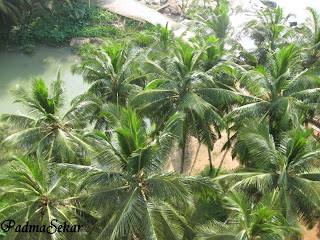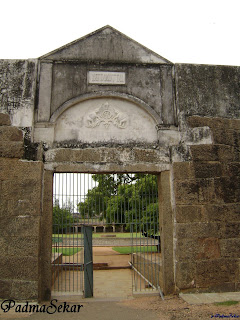Saturday, August 28, 2010
Mathur Thottipalam 1
It is the tallest as well as the longest trough bridge in Asia, having a height of 101 feet and a length of one kilometre. This is situated in Mathur, hamlet of Aruvikkarai revenue village in Thiruvattar Panchayat Union. It is across the river Parazhiyar.
The canal on the bridge carries water for irrigation from one side of a hill to the other side of a hill. The trough has a height of seven feet with a width of seven feet six inches.
The canal is being shouldered by 28 huge pillars. By the efforts of late Thiru. K. Kamaraj, the former Chief Minister of Tamil Nadu in 1966, this canal was constructed as a drought relief measure and for the development of agriculture in Vilavancode and Kalkulam Taluks
On the way to Mathur from Thirparappu
The canal on the bridge carries water for irrigation from one side of a hill to the other side of a hill. The trough has a height of seven feet with a width of seven feet six inches.
The canal is being shouldered by 28 huge pillars. By the efforts of late Thiru. K. Kamaraj, the former Chief Minister of Tamil Nadu in 1966, this canal was constructed as a drought relief measure and for the development of agriculture in Vilavancode and Kalkulam Taluks
On the way to Mathur from Thirparappu
Thursday, August 26, 2010
Vattakottai 2
There is a pond and a well are in the middle of the fort and four mandabams used as rest rooms and weapon rooms in the four sides.
There are a set of stairs, next to a steep slope, which was used to haul cannons up to the parade ground. Elephants would use the stairs on either side to drag the cannons up the slope.
Eastern side - sea
Southern side we can see Kanya kumari and the beach is famous for different color soil, which is not accessible to the public now a days.
Northern side beach,
There are a set of stairs, next to a steep slope, which was used to haul cannons up to the parade ground. Elephants would use the stairs on either side to drag the cannons up the slope.
Eastern side - sea
Southern side we can see Kanya kumari and the beach is famous for different color soil, which is not accessible to the public now a days.
Northern side beach,
Vattakottai 1
Vattakottai (or 'Circular Fort') is a seaside fort near Kanyakumari. It was built in the 18th century as a coastal defence-fortification in the Travancore kingdom.
It was constructed under the supervision of Captain Eustachius De Lannoy, an ex-Dutch naval officer of the Dutch East India Company, who became commander of the Travancore army (the very army that defeated him in the Battle of Colachel) in the 18th century, after he earned the trust of the Travancore King Marthanda Varma. De Lannoy constructed Vattakottai, as part of the defence-fortifications he undertook throughout Travancore.
The fort is made of granite blocks and, today, a part of the fort extends into the sea. It is a protected site under the Indian archaeological department.
Also can see a cannon ball placed on the ground...
Northern side of the Fort looks like a forest, Tourism department has to develop it clean
You can see the wind turbines and Koodankulam Nuclear plant at a farther distance in the northern side
It was constructed under the supervision of Captain Eustachius De Lannoy, an ex-Dutch naval officer of the Dutch East India Company, who became commander of the Travancore army (the very army that defeated him in the Battle of Colachel) in the 18th century, after he earned the trust of the Travancore King Marthanda Varma. De Lannoy constructed Vattakottai, as part of the defence-fortifications he undertook throughout Travancore.
The fort is made of granite blocks and, today, a part of the fort extends into the sea. It is a protected site under the Indian archaeological department.
Entrance
We can see the emblem of CHERA kings in the entrance
Also can see a cannon ball placed on the ground...
There is an arch in the front wall, set with a tiny square peephole. Through it we can have a wide view of coconut trees and hills ) . It is believed that, there's supposed to be a tunnel that runs from the fort to the palace to Padmanabapuram palace. But it caved in and has been closed for year.
Northern side of the Fort looks like a forest, Tourism department has to develop it clean
You can see the wind turbines and Koodankulam Nuclear plant at a farther distance in the northern side
Subscribe to:
Posts (Atom)




















































